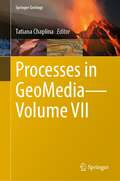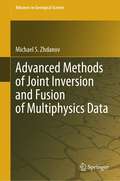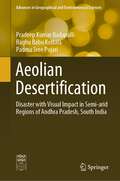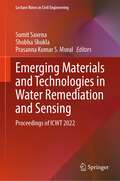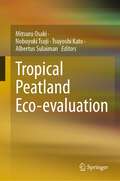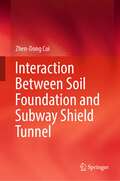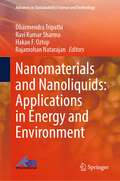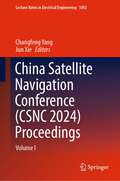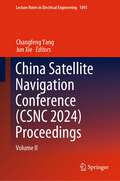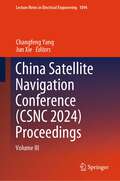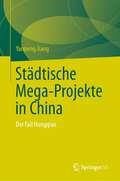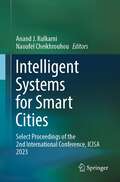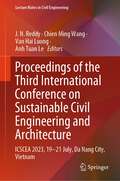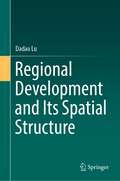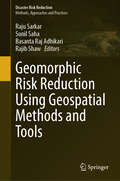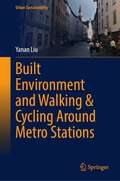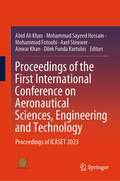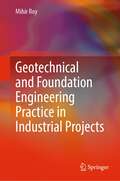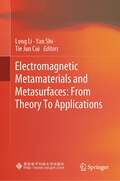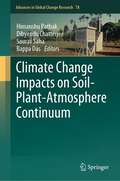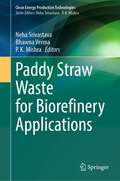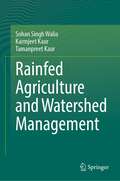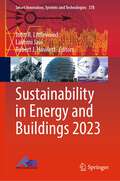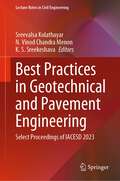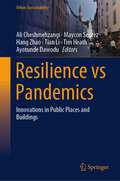- Table View
- List View
Processes in GeoMedia—Volume VII (Springer Geology)
by Tatiana ChaplinaThis book includes new results of theoretical and experimental studies of various scales of the processes occurring on the earth including the lithosphere, atmosphere, and hydrosphere. Intensive development of research in these areas is due to several factors: 1) the widespread introduction of computer technology, allowing the calculation of complex phenomena; 2) the invention and improvement of a new generation of geophysical instruments such as remote observation systems based on ships, aircraft, and satellites, providing a large amount of data to objectively reflect a broad picture of the processes; and 3) the development of measurement techniques, creating opportunities for controllable and reproducible laboratory data acquisition for generation of new ideas and concepts. Their recent developments have facilitated our research and understanding of these academic fields. The book enriches the understanding of the geophysical processes taking place in various environments (lithosphere, hydrosphere, and atmosphere), including the anthropogenic one, and it further contributes to their development. This book is a valuable resource for specialists working in the oil, gas, and engineering industry to improve their understandings of the field.
Advanced Methods of Joint Inversion and Fusion of Multiphysics Data (Advances in Geological Science)
by Michael S. ZhdanovDifferent physical or geophysical methods provide information about distinctive physical properties of the objects, e.g., rock formations and mineralization. In many cases, this information is mutually complementary, which makes it natural for consideration in a joint inversion of the multiphysics data. Inversion of the observed data for a particular experiment is subject to considerable uncertainty and ambiguity. One productive approach to reducing uncertainty is to invert several types of data jointly. Nonuniqueness can also be reduced by incorporating additional information derived from available a priori knowledge about the target to reduce the search space for the solution. This additional information can be incorporated in the form of a joint inversion of multiphysics data.Generally established joint inversion methods, however, are inadequate for incorporating typical physical or geological complexity. For example, analytic, empirical, or statistical correlations between different physical properties may exist for only part of the model, and their specific form may be unknown. Features or structures that are present in the data of one physical method may not be present in the data generated by another physical method or may not be equally resolvable.This book presents and illustrates several advanced, new approaches to joint inversion and data fusion, which do not require a priori knowledge of specific empirical or statistical relationships between the different model parameters or their attributes. These approaches include the following novel methods, among others: 1) the Gramian method, which enforces the correlation between different parameters; 2) joint total variation functional or joint focusing stabilizers, e.g., minimum support and minimum gradient support constraints; 3) data fusion employing a joint minimum entropy stabilizer, which yields the simplest multiphysics solution that fits the multi-modal data. In addition, the book describes the principles of using artificial intelligence (AI) in solving multiphysics inverse problems. The book also presents in detail both the mathematical principles of these advanced approaches to joint inversion of multiphysics data and successful case histories of regional-scale and deposit-scale geophysical studies to illustrate their indicated advantages.
Aeolian Desertification: Disaster with Visual Impact in Semi-arid Regions of Andhra Pradesh, South India (Advances in Geographical and Environmental Sciences)
by Pradeep Kumar Badapalli Raghu Babu Kottala Padma Sree PujariThis book summarizes contemporary research on land degradation, desertification, and how such issues relate to socioeconomic growth in developing countries. With a focus on local and regional levels, the book offers an in-depth analysis of aeolian action as a physical process, causes of land degradation, and desertification. The causes and effects of land degradation were investigated by utilizing multiscale and multidisciplinary methodologies, merging spatial socioeconomic data with remote sensing data, and using multiple levels and disciplinary approaches. The book also describes how to combine GIS with cutting-edge technologies such as remote sensing, geostatistics, scanning electron microscopy (SEM) and energy-dispersive X-ray (EDAX) analysis, and analytical hierarchy approaches, among others. Included is a thorough case study of the unusual but understudied semi-arid Anantapur district in Andhra Pradesh, South India. This book encourages the participation of all socioeconomic groups in decision-making and assists authorities and planners in developing suitable plans for the sustainable agricultural growth of an area. The book is an invaluable resource to comprehend and resolve issues about sustainable environmental planning and management.
Emerging Materials and Technologies in Water Remediation and Sensing: Proceedings of ICWT 2022 (Lecture Notes in Civil Engineering #439)
by Sumit Saxena Shobha Shukla Prasanna Kumar S. MuralThis book presents the select proceedings of 2nd International Conference on Water Technologies 2022. While several efforts are underway, materials form the core of all research activities to develop technologies to mitigate the global challenge of water crisis. This book includes latest scientific dialogues, state-of-the-art developments in terms of emerging materials, technology development aimed toward mitigating various bottlenecks in water treatment, purification, desalination, and sensing with emerging materials. It also discusses diverse materials driven approaches, including theoretical and experimental studies, to address various aspects of this global issue. The book discusses various topics related to nanomaterials for water purification, bio-physical remediation, photocatalysis, membranes, physico-chemical processes, oil-water separation, sensors, and microplastics, etc. The book can be a valuable reference for beginners, researchers, and professionals interested in water technologies and allied fields.
Tropical Peatland Eco-evaluation
by Mitsuru Osaki Nobuyuki Tsuji Tsuyoshi Kato Albertus SulaimanThis book focuses on eco-evaluation system monitoring and sensing, carbon-water modeling, mapping, and disaster prediction. It is the 3rd book on tropical peatland issues, following 1st "Tropical Peatland Ecosystem" and 2nd "Tropical Peatland Eco-management" publications. Tropical peatland is also a wetland, mangrove, and rainforest. With this nature, two major key elements of tropical peatland are water and forest. This book introduces the relationship and interaction among water, oxygen, and nutrients as well as aspects of the forest as the driving force of carbon stock and the carbon cycle. Eco-evaluation system is key to conserving, managing, and restoring tropical peatlands, however comprehensive system for Eco-evaluation in the Tropics is not yet established. This book reviews and proposes Eco-evaluation methods in the Tropics Ecosystem, focusing mainly on the peatland ecosystem and others, covering Social Capital such as Credit, Bonds, National Accounting, etc.
Interaction Between Soil Foundation and Subway Shield Tunnel
by Zhen-Dong CuiThis book addresses the interaction between the soil foundation and the subway shield tunnels under the vibration loading, including the dynamic response of the track inside the shield tunnel, the dynamic properties of soil around the subway shield tunnel, the mechanical properties of subway tunnel, and the long-term settlement of the subway tunnel. Given its scope, it offers a valuable reference guide for designers and construction researchers alike, as well as senior undergraduates and graduate students at colleges and universities.
Nanomaterials and Nanoliquids: Applications in Energy and Environment (Advances in Sustainability Science and Technology)
by Dharmendra Tripathi Ravi Kumar Sharma Hakan F. Oztop Rajamohan NatarajanThis book discusses recent work on the use of nanoparticles in energy and environment-related work. This book presents experimental, numerical, analytical, and theoretical work on the use of nanomaterials in energy and environment. This book helps to highlight cutting-edge research and is a ready reference for the researchers working in this arena of academia and industries. This book provides insights related to various forms of nanotechnological applications in green buildings, environmental and electrochemical, solar distillation systems, green energy, storage tank of the SWH system, solar concentrator system's receiver, and CFD simulations of various aspects of nanofluids/hybrid nanofluids, which are particularly useful, valuable for the betterment of society.
China Satellite Navigation Conference: Volume I (Lecture Notes in Electrical Engineering #1092)
by Changfeng Yang Jun XieThis book presents selected research papers from China Satellite Navigation Conference (CSNC) 2024, held in Jinan, China, on 22–24 May 2024. These papers discuss the technologies and applications of the Global Navigation Satellite System (GNSS) and in particular the latest advances in the China BeiDou System (BDS). They are divided into 8 topics to match the corresponding sessions at CSNC 2024, which broadly covered key topics in GNSS. Readers learn about the BDS and keep abreast of the latest advances in GNSS technologies and applications.
China Satellite Navigation Conference: Volume II (Lecture Notes in Electrical Engineering #1093)
by Changfeng Yang Jun XieThis book presents selected research papers from China Satellite Navigation Conference (CSNC) 2024, held in Jinan, China, on 22–24 May 2024. These papers discuss the technologies and applications of the Global Navigation Satellite System (GNSS) and in particular the latest advances in the China BeiDou System (BDS). They are divided into 8 topics to match the corresponding sessions at CSNC 2024, which broadly covered key topics in GNSS. Readers learn about the BDS and keep abreast of the latest advances in GNSS technologies and applications.
China Satellite Navigation Conference: Volume III (Lecture Notes in Electrical Engineering #1094)
by Changfeng Yang Jun XieThis book presents selected research papers from China Satellite Navigation Conference (CSNC) 2024, held in Jinan, China, on 22–24 May 2024. These papers discuss the technologies and applications of the Global Navigation Satellite System (GNSS) and in particular the latest advances in the China BeiDou System (BDS). They are divided into 8 topics to match the corresponding sessions at CSNC 2024, which broadly covered key topics in GNSS. Readers learn about the BDS and keep abreast of the latest advances in GNSS technologies and applications.
Städtische Mega-Projekte in China: Der Fall Hongqiao
by Yanpeng JiangDieses Buch ist die erste systematische Darstellung von städtischen Megaprojekten in China, die sich mit deren Bau, Betrieb und Planung befasst. Es ist eine detaillierte Untersuchung der Planung und des Baus von Hongqiao und seiner Auswirkungen auf die Anwohner. Kurz gesagt, das Ziel dieses Buches ist es, den Planungs- und Entwicklungsprozess der Verkehrs- und Handelszone Hongqiao zu untersuchen, ihre Beziehung zur Stadtentwicklung und zur räumlichen Umstrukturierung in Shanghai zu erforschen und dabei die Art des städtischen Wandels im heutigen China zu kommentieren und zu kritisieren, der als eigentums- und infrastrukturgetrieben charakterisiert wird. Städtische Megaprojekte sind wohl das Symbol des unternehmerischen Urbanismus schlechthin, und es ist kein Zufall, dass sie in der ganzen Welt, nicht zuletzt in Ostasien, zu einem vertrauten Bestandteil der städtischen Szene geworden sind. Sie können sowohl als Folge der Deindustrialisierung führender Städte, zunächst in Nordamerikaund Europa und dann in Ostasien, als Reaktion auf den Übergang der Volkswirtschaften zum globalisierten Neoliberalismus betrachtet werden. Dieses Buch bietet einen umfassenden Überblick über die Hauptmerkmale der in Hongqiao gebildeten landbasierten städtischen Wachstumskoalition, indem es das Hongqiao-Projekt im Detail vorstellt und das jüngste Beispiel des wettbewerbsorientierten Ansturms auf städtische Projekte in Chinas größten Städten skizziert, der zur Ausbreitung neuer Finanzdistrikte in Beijing und Guangzhou geführt hat.
Intelligent Systems for Smart Cities: Select Proceedings of the 2nd International Conference, ICISA 2023
by Anand J. Kulkarni Naoufel CheikhrouhouThis book presents the select proceedings of the 2nd International Conference on Intelligent Systems and Applications 2023. The theme of this conference is ‘Intelligent Systems for Smart Cities'. It covers the topics of intelligent systems in multiple aspects such as healthcare, supply chain and logistics, smart homes and smart structures, banking and finance, a sustainable environment, social media and cyber security, crime prevention, and disaster management. The book will be useful for researchers and professionals interested in the broad field of artificial intelligence and machine learning.
Proceedings of the Third International Conference on Sustainable Civil Engineering and Architecture: ICSCEA 2023, 19–21 July, Da Nang City, Vietnam (Lecture Notes in Civil Engineering #442)
by J. N. Reddy Chien Ming Wang Van Hai Luong Anh Tuan LeThis book includes articles from the Third International Conference on Sustainable Civil Engineering and Architecture (ICSSEA 2023), held at Da Nang City, Vietnam, on July 19-21, 2023. The conference brings together international experts from both academia and industry to share their knowledge and expertise, facilitate collaboration, and improve cooperation in the field. The book focuses on the most recent developments in sustainable architecture and civil engineering, including offshore structures, structural engineering, building materials, and architecture.
Regional Development and Its Spatial Structure
by Dadao LuThis book describes the progress and prominent theories of regional development research in the past decades, especially in the past decade, discusses the industrial structure, spatial structure, resources, and environment, as well as a series of practical issues, and reveals the general characteristics of spatial structure evolution in the process of regional development. The research on the issues of regional development has become the frontier of relevant disciplines since the 1950s, and much progress has been made in the process of solving practical problems in social and economic development. This book provides an in-depth and systematic demonstration of the "point-axis system" theory of regional exploitation and development as well as the T-shaped structure of China's regional economic action in theory and practice and discusses the impact of location differential rent, restricted accessibility, technological innovation, etc., on regional development theoretically. This book is used as a reference for planning, scientific research, and teaching personnel in territorial expansion, regional economy, human geography, etc.
Geomorphic Risk Reduction Using Geospatial Methods and Tools (Disaster Risk Reduction)
by Raju Sarkar Sunil Saha Basanta Raj Adhikari Rajib ShawThis book explores the use of advanced geospatial techniques in geomorphic hazards modelling and risk reduction. It also compares the accuracy of traditional statistical methods and advanced machine learning methods and addresses the different ways to reduce the impact of geomorphic hazards.In recent years with the development of human infrastructures, geomorphic hazards are gradually increasing, which include landslides, flood and soil erosion, among others. They cause huge loss of human property and lives. Especially in mountainous, coastal, arid and semi-arid regions, these natural hazards are the main barriers for economic development. Furthermore, human pressure and specific human actions such as deforestation, inappropriate land use and farming have increased the danger of natural disasters and degraded the natural environment, making it more difficult for environmental planners and policymakers to develop appropriate long-term sustainability plans. The most challenging task is to develop a sophisticated approach for continuous inspection and resolution of environmental problems for researchers and scientists. However, in the past several decades, geospatial technology has undergone dramatic advances, opening up new opportunities for handling environmental challenges in a more comprehensive manner.With the help of geographic information system (GIS) tools, high and moderate resolution remote sensing information, such as visible imaging, synthetic aperture radar, global navigation satellite systems, light detection and ranging, Quickbird, Worldview 3, LiDAR, SPOT 5, Google Earth Engine and others deliver state-of-the-art investigations in the identification of multiple natural hazards. For a thorough examination, advanced computer approaches focusing on cutting-edge data processing, machine learning and deep learning may be employed. To detect and manage various geomorphic hazards and their impact, several models with a specific emphasis on natural resources and the environment may be created.
Built Environment and Walking & Cycling Around Metro Stations (Urban Sustainability)
by Yanan LiuThis book explores the relationship between pedestrians/cyclists’ mode and route choice to/from metro/railway stations and the micro-level (street-scale) built environment in a second-tier city in China. More specifically, it investigates how the street-scale built environment influences pedestrians/cyclists’ mode choice and route choice behavior and examines user preferences for the micro-level built environment around metro stations. The focus on a second-tier city is motivated primarily to expand the set of Chinese cities where the effects of the built environment on pedestrian/cyclist mode and route choice have been studied. Results demonstrate the effects of the street-scale built environment on pedestrian flows. The effects are higher for the main road, which is directly connected with the metro station. The findings of this book are expected to support the design of preferred walking/biking built environments around a metro station. This book appeals to urbanists, planners, engineers, policy makers, and those interested in a wide-ranging overview of slow/green transportation and built environment promotion. These methods not only help to understand the quantitative relationship between built environment design and travel behavior but also support the evaluation and assessment of built environment design in urban planning projects. It reduces the gap in our understanding of the quantitative relationship between the micro-level built environment and pedestrians/cyclists’ transportation mode and route choice around the metro station. Both stated choice data and revealed choice data were used. An extended set of micro-level built environment attributes was developed. Besides the widely studied transportation-related factors, street-level built environment factors were studied using quantitative methods.
Proceedings of the First International Conference on Aeronautical Sciences, Engineering and Technology: Proceedings of ICASET 2023
by Abid Ali Khan Mohammad Sayeed Hossain Mohammad Fotouhi Axel Steuwer Anwar Khan Dilek Funda KurtulusThis volume contains forty-one revised and extended research articles, written by prominent researchers participating in the International Conference on Aeronautical Sciences, Engineering and Technology 2023, held in Muscat, October 3-5 2023. It focuses on the latest research developments in aeronautical applications, avionics systems, advanced aerodynamics, atmospheric chemistry, emerging technologies, safety management, unmanned aerial vehicles, and industrial applications. This book offers the state of the art of notable advances in engineering technologies and aviation applications and serves as an excellent source of reference for researchers and graduate students.
Geotechnical and Foundation Engineering Practice in Industrial Projects
by Mihir RoyThis professional book is an important resource on the topics of geotechnical and foundation engineering for practicing engineers and consultants. It fills the gap between classroom education and real-world professional practice in green and brown field projects. It provides hands-on knowledge on various topics such as engineering geology, geotechnical investigation, site preparation, ground improvement, foundation on soft and filled-up soil, pile foundation, seepage control, erosion control and retaining wall, marine projects, simplified liquefaction potential assessment, tailing storage management at mines, failure during construction, site hazard and remedy and geotechnical and foundation engineering practice. This book will be highly useful for professionals and practicing engineers in the area of geotechnical and foundations engineering. It will also be a useful reference for graduate and postgraduate students and the faculty in the same field.
Electromagnetic Metamaterials and Metasurfaces: From Theory To Applications
by Long Li Yan Shi Tie Jun CuiThe subject of this book is the fast-developing area of research known as metamaterials/metasurfaces and some of their engineering applications. This book comprehensively presents the state of the art of metamaterials/metasurfaces from theory to applications. The theoretical side includes electrodynamics of left-handed medium, generalized Snell's law, digital coding metamaterials/metasurfaces, group theory of metamaterials, information metamaterials and metasurfaces, etc. On the application side, a wide range of design examples are discussed, including metamaterial antennas, electromagnetic interference, frequency selective surfaces, wireless power transmission and energy harvesting, cloaking and radar cross section reduction, orbital angular momentum, wireless communication, imaging, etc. The book provides researchers, engineers, and graduate students with a variety of new discoveries, results, information, and knowledge in the field of metamaterials and metasurfaces.
Climate Change Impacts on Soil-Plant-Atmosphere Continuum (Advances in Global Change Research #78)
by Himanshu Pathak Dibyendu Chatterjee Saurav Saha Bappa DasThis book explores the interaction between climate change phenomena and the soil–plant–atmosphere continuum (SPAC), which inspects the crucial role of anthropogenic greenhouse gas emissions in modifying the net ecosystem response towards the modified environment. Increasing concentration of anthropogenic greenhouse gases (carbon dioxide, methane and nitrous oxide) from massive deforestation, fossil fuel burning and rapid industrialization in the post-nineteenth century have led to adverse changes in our global climate system. The book evaluates the net impact of climate change on soil, plants and the atmosphere individually and in totality. Among the topics it covers are the impact of climate change on soil environment which encompasses soil processes, nutrient cycling, soil carbon sequestration, soil biota response and soil health management. Also included are the impact on plants with respect to the dry matter assimilation pattern, modification in resource use efficiency, rhizosphere interactions, management of biotic and abiotic stress factors, and regulatory mechanisms of biotic stress factors in modifying the net agroecosystem response towards climate change. Moreover, potential genetic engineering options for establishing C4 or Crassulacean acid metabolism (CAM) in C3 plants, heat–drought stress on pollen biology, breeding ideotype, ecological indicators and crop simulation modelling are considered. Lastly, the impact on the atmosphere takes into account greenhouse gas measurements, mitigation options, eddy covariance measurement of greenhouse gasses, satellite-based monitoring, ecosystem services, abiotic stress management options, air pollution and atmospheric modelling. This book is a valuable resource for researchers, students and policymakers in understanding climate change impacts on interaction processes among the atmosphere, soil and plants from the local to regional scales.
Paddy Straw Waste for Biorefinery Applications (Clean Energy Production Technologies)
by Neha Srivastava Bhawna Verma P. K. MishraThis book provides an exclusive and critical in-depth analysis of paddy straw waste valorization at a broad scale for different industrial applications. It explores and discusses the various valorization pathways of paddy straw into valuable products connected to biorefineries' products and byproducts. The book also examines the scope, potential, and availability of paddy straw in the field of biorefineries. Various lignocellulosic biomasses with expanded potential are known for their industrial applications, even at a broad pilot range. Among these biomasses, paddy straw has emerged as the most suitable lignocellulosic waste for various biorefinery applications. Paddy is a crucial and widely consumed crop globally, and it generates the highest annual production of waste compared to other cereal crops. The cellulose content, accounting for approximately 47% of the total cellulosic biomass, offers significant potential for valorization, along with hemicellulose and lignin, which can also be explored and expanded on an industrial scale. However, despite the tremendous scope for valorization, lignocellulosic biomass-based biorefineries face cost-effectiveness challenges that need to be addressed for sustainable and uniform expansion, distribution, and economic scalability in various applications. The book's specific feature lies in its targeted and specific valorization of paddy straw into biofuels and other biorefinery-based products, which hold promising industrial applications and easily scalable approaches for mass production. This book is an essential resource for students, scientists, engineers and practitioners working in the biorefinery industry and academia.
Rainfed Agriculture and Watershed Management
by Sohan Singh Walia Karmjeet Kaur Tamanpreet KaurThis book provides a comprehensive explanation of rainfed farming, dryland agriculture, and watershed management concepts. Despite utilizing all available water resources for irrigation, approximately half of the cultivated land will still rely on rainfall. With limited scope for expanding cultivated areas, meeting future food demands becomes an immense challenge. It is within this context that the significance of dryland agriculture emerges.Indian agriculture relies heavily on the monsoon, making water crucial for sustainable development. Unequal distribution of the global average rainfall (about 1000 mm) contributes to disparities in agriculture and socio-economic conditions. Around 70% of India's agriculture depends on rainfall, producing nearly 44% of the food and supporting 40% of the human and 60% of the livestock population. Even with full irrigation potential, half of cultivated land still relies on rain. Approximately 30% of the country is prone to drought and water scarcity, posing challenges for rainfed agriculture. Inefficient water use affects other inputs, emphasizing the need for resource management and indigenous systems.This book serves as a valuable resource for farmers, students, and scholars by providing guidance on various aspects of rainfed agriculture, dryland farming, and watershed resource management techniques. It aims to optimize the use of irrigation water and foster sustainable agricultural development. Additionally, it caters to the needs of graduate and postgraduate students studying agriculture, offering specific insights relevant to their designated course on rainfed agriculture and watershed management.
Sustainability in Energy and Buildings 2023 (Smart Innovation, Systems and Technologies #378)
by John R. Littlewood Lakhmi Jain Robert J. HowlettThis book contains the proceedings of the 15th KES International Conference on Sustainability and Energy in Buildings 2023 (SEB2023) held in Bari, Italy, during September 18–20, 2023, organized by KES International. SEB23 invited contributions on a range of topics related to sustainable buildings and explored innovative themes regarding sustainable energy systems. The conference formed an exciting chance to present, interact, and learn about the latest research and practical developments on the subject. The conference attracted submissions from around the world. Submissions for the full-paper track were subjected to a blind peer-reviewed process. Only the best of these were selected for presentation at the conference and publication in these proceedings. It is intended that this book provides a useful and informative snapshot of recent research developments in the important and vibrant area of sustainability in energy and buildings.
Best Practices in Geotechnical and Pavement Engineering: Select Proceedings of IACESD 2023 (Lecture Notes in Civil Engineering #449)
by Sreevalsa Kolathayar N. Vinod Chandra Menon K. S. SreekeshavaThis book presents select proceedings of the International Conference on Interdisciplinary Approaches in Civil Engineering for Sustainable Development (IACESD 2023). The topics covered include emerging practices in geotechnical engineering and pavement, innovative approaches, and technologies to enhance the durability, sustainability, and performance of infrastructure, geosynthetics, geotechnical monitoring systems, and ground improvement techniques to address soil stability, settlement, and liquefaction issues. This book is useful for researchers and professionals’ geotechnical engineering.
Resilience vs Pandemics: Innovations in Public Places and Buildings (Urban Sustainability)
by Ali Cheshmehzangi Maycon Sedrez Hang Zhao Tian Li Tim Heath Ayotunde Dawodu“Resilience vs Pandemics: Innovations in Public Places and Buildings” explores innovative solutions for architecture and public places during and after the pandemic. Additionally, the authors contribute to the documentation of architectural and social transformations that have been prompted by previous transmissible diseases, as this knowledge can inform responses to future pandemics. In this volume, the chapters present critical, exploratory, multi- and interdisciplinary, and cutting-edge research approaches; with a particular focus on the effects of COVID-19 and other highly transmissible diseases on the design, use, performance, and perception of the built environment, particularly at the building scale. This volume aims to organize a collection of scientific studies, reviews, analysis, recommendations, and solutions in the fields of urban design, architecture, design, landscape design, etc. The overarching goal is to document new approaches to create and enhance built environment resilience. Chapters shed light on novel methods, tools, processes, regulations, behaviours, and other relevant details contributing to a comprehensive understanding of this crucial issue. The two scales of the built environment under consideration are: (1) Public Places, including research on transformations (death, emergencies, changes), requirements, adaptability, usability, virtual immersion, historical perspectives, interactivity, shifts in use and programs, etc.(2) Buildings, including regulations, shifts in use and program, non-pharmaceutical interventions, human interactions, and human-machine interfaces. The book covers a wide range of studies, including physical and non-physical studies, which may refer to the city infrastructure, green/blue spaces, housing, policy-making, health services, social and economic issues, etc. The findings and results of various global case study examples contribute to the decision-making of governments, organizations, and institutions, as well as inspire scholars and future research for developing resilience in the post-pandemic era.
